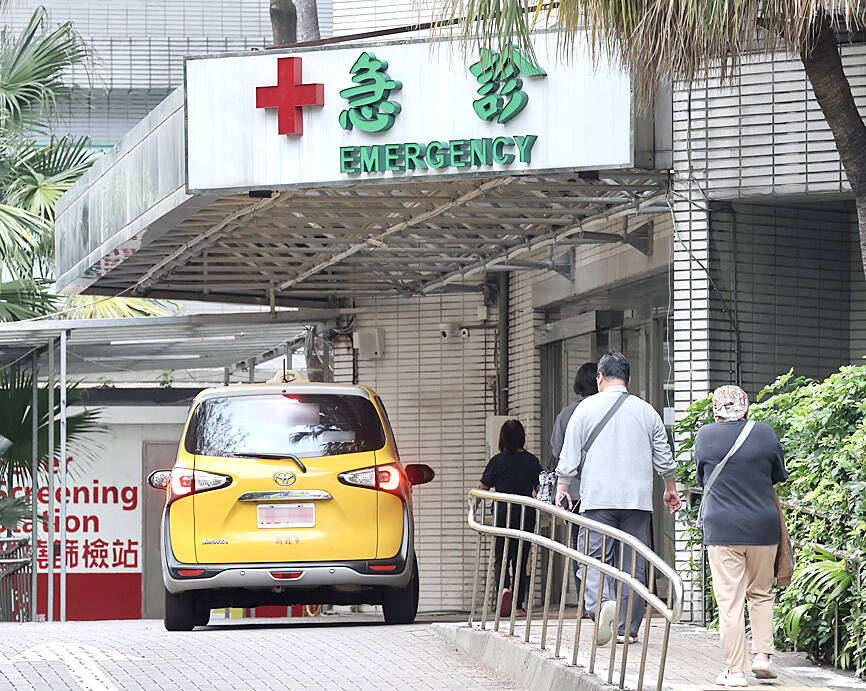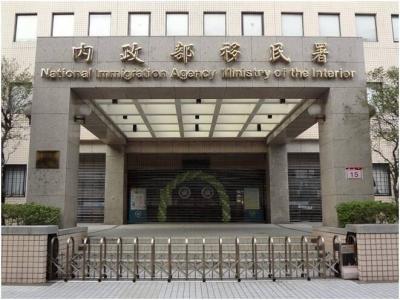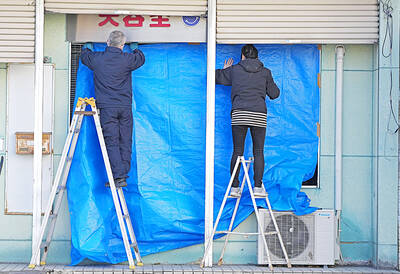The Ministry of Health and Welfare yesterday said it is mulling establishing new nurse-patient ratio standards and bonuses for nurses working three shifts in emergency rooms (ERs), following reports of overcrowded ERs.
After the Lunar New Year holiday, healthcare providers have been urging the government to help solve the problem of overcrowded ERs, with the Taiwan Society of Emergency Medicine last month calling the seriousness of the problem “unprecedented.”
After President William Lai (賴清德) and Premier Cho Jung-tai (卓榮泰) last week instructed the ministry to carry out improvement measures, Minister of Health and Welfare Chiu Tai-yuan (邱泰源) and department heads yesterday held an impromptu news conference.

Photo: CNA
According to the Establishment Standards for Medical Institutions (醫療機構設置標準) and hospital accreditation standards, there should be one nurse per bed in the emergency observation rooms, and at least one nurse per 12 ER patients, Department of Nursing and Healthcare Director-General Tsai Shu-feng (蔡淑鳳) said.
Hospitals adjust their nursing deployment to meet the needs of ER patients, with some having other support staff to assist when there are too many patients and using an ER dashboard to display real-time data of patient flow and capacity, Tsai said.
“Amid the ER overcrowding issue, we have heard calls for increasing the number of nurses and setting nurse-patient ratios for three shifts in ERs,” she said. “We have heard the suggestions and are discussing them.”

Photo: CNA
Ministry departments would also discuss the nurse-patient ratios in different areas of ERs, such as the triage area, observation room and first aid area, she said.
Due to limited funding last year, the night shift bonus was provided to nurses taking care of patients in acute care hospital beds, but this year it would be expanded to all beds in special hospital wards, including those in ERs and intensive care units, she said.
Tsai acknowledged that there is a nursing shortage and said that the ministry last year established the standards of nurse-patient ratios for three shifts to maintain a reasonable workload, and the compliance rates have increased.
In January, the average compliance rates at medical centers, regional hospitals and district hospitals were 59 percent, 49 percent and 86 percent respectively, department data show.
There is still a nurse shortage, and the compliance rates have not achieved 100 percent, Tsai said.
In medical centers, the compliance rates for the graveyard shift are the lowest, ranging from 32 percent to 63 percent from March last year to January, while the compliance rate reached 100 percent for the day shift in the past few months, she said.
There are also seasonal changes in the number of nurses in the workforce — with more people leaving the workforce from January to April, and more people joining from September to November, she said.
Comparing data from February last year and last month, the number of registered nurses increased by 3,531 people, while nurses in the workforce have increased by 1,428 people, she added.
The ministry has allocated NT$4.7 billion (US$142.78 million) for night shift bonuses, NT$1.6 billion for nurse-patient ratio compliance rewards, NT$15 million for nurse-friendly workplace certification, and NT$360 million for establishing a nursing training system, she said.

A small number of Taiwanese this year lost their citizenship rights after traveling in China and obtaining a one-time Chinese passport to cross the border into Russia, a source said today. The people signed up through Chinese travel agencies for tours of neighboring Russia with companies claiming they could obtain Russian visas and fast-track border clearance, the source said on condition of anonymity. The travelers were actually issued one-time-use Chinese passports, they said. Taiwanese are prohibited from holding a Chinese passport or household registration. If found to have a Chinese ID, they may lose their resident status under Article 9-1

Taiwanese were praised for their composure after a video filmed by Taiwanese tourists capturing the moment a magnitude 7.5 earthquake struck Japan’s Aomori Prefecture went viral on social media. The video shows a hotel room shaking violently amid Monday’s quake, with objects falling to the ground. Two Taiwanese began filming with their mobile phones, while two others held the sides of a TV to prevent it from falling. When the shaking stopped, the pair calmly took down the TV and laid it flat on a tatami mat, the video shows. The video also captured the group talking about the safety of their companions bathing

A classified Pentagon-produced, multiyear assessment — the Overmatch brief — highlighted unreported Chinese capabilities to destroy US military assets and identified US supply chain choke points, painting a disturbing picture of waning US military might, a New York Times editorial published on Monday said. US Secretary of Defense Pete Hegseth’s comments in November last year that “we lose every time” in Pentagon-conducted war games pitting the US against China further highlighted the uncertainty about the US’ capability to intervene in the event of a Chinese invasion of Taiwan. “It shows the Pentagon’s overreliance on expensive, vulnerable weapons as adversaries field cheap, technologically

Starting on Jan. 1, YouBike riders must have insurance to use the service, and a six-month trial of NT$5 coupons under certain conditions would be implemented to balance bike shortages, a joint statement from transportation departments across Taipei, New Taipei City and Taoyuan announced yesterday. The rental bike system operator said that coupons would be offered to riders to rent bikes from full stations, for riders who take out an electric-assisted bike from a full station, and for riders who return a bike to an empty station. All riders with YouBike accounts are automatically eligible for the program, and each membership account